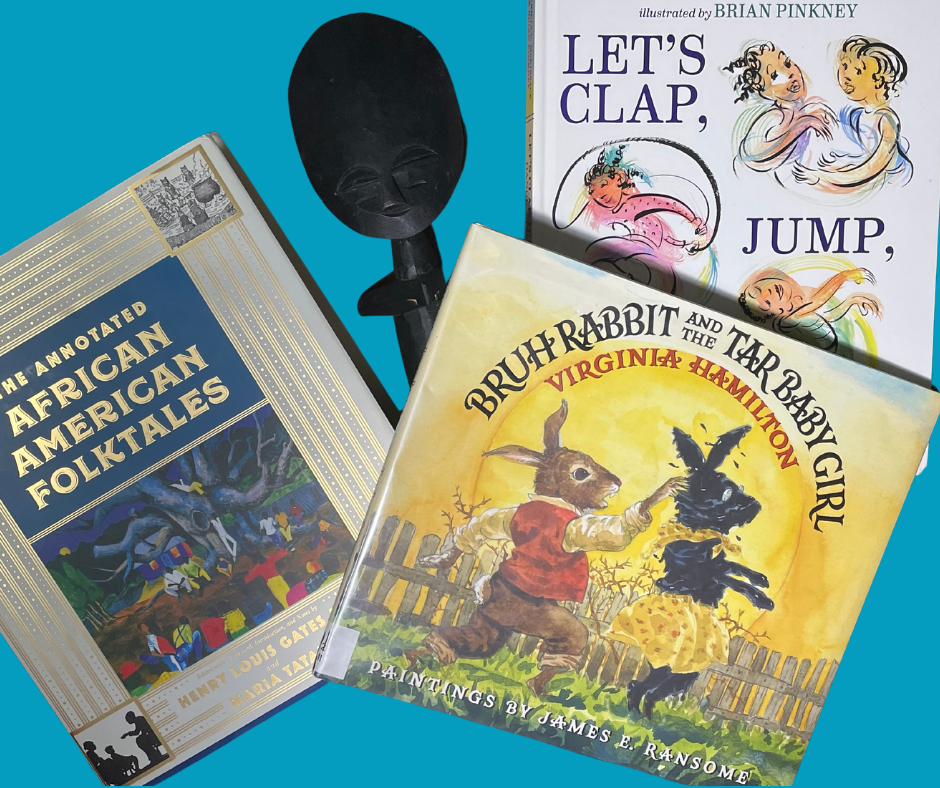Bruh Rabbit and the Tar Baby: Resilience and Resistance
Retold by Virginia Hamilton
Illustrated by James E. Ransome
Everyone knew the story of B’rer Rabbit and the Tar Baby.
Like…everyone.
The story has variants all over the world. Similar stories have been told in Western Africa, and India, and Spain, and the Philippines, and Native American tribes, and the Caribbean, and the American South…
The animals may be different. The sticky object varies. But on the surface, it’s a story about “outlaw peasant outwits inventive master with wit and cunning,” according to folklorists who look for common motifs.
The (hundreds of) versions told in the American South have gone through some rough times, as we wrestle with our history of slavery, and racism, and cultural appropriation.
But in their book, The Annotated African American Folktales, scholars Henry Lousi Gates, Jr, and Maria Tatar write:
“Is it any wonder that the story of the tar baby came to be enshrined as slavery’s most ubiquitous narrative, paradoxically capturing both the physical impossibility of liberation as well as the intellectual hope of using words and wit to elude captivity?”
Overcoming adversities, large and small, is the “why” of resilience.
This story offers some insight into the “how” of resilience.
Bruh Rabbit isn’t some paragon of virtue, held up as a model for kids. Instead, he sneaks into fields when he is hungry (think: Peter Rabbit).
And when Tar Baby Girl doesn’t talk back to him: he smacks her and gets completely stuck. (One reason he’s fallen from favor).
But when Bruh Rabbit’s self-regulation fails, it’s his quick wits that spring him right back to his briar patch.
Love him or hate him, this small and seemingly helpless bunny, like his folk and fairy tale cousins around the world, has a lot to teach us about agency, perseverance…and history.
Some of the many resources I drew on for this week’s post!
What in TAR-nation??? It’s SLIME!!!
So…do your kids even know what tar IS?
What if I were to tell you that helping them to make stronger connections and visualize the story through first-hand experience could also develop self-regulation?!
It’s true! And everyone’s favorite/most-disliked sensory material is how!
Try making black slime to play with!
Just add black tempera paint or food coloring to your favorite slime recipe and you have a safe, sticky, easy to clean up substance to explore tar baby girl’s power.
Don’t have a favorite slime recipe? Since it’s been a minute since I’ve made slime with kids, I did some research.
I found this article that compared five slime recipes especially helpful.
How it develops self-regulation:
Kids can help to carefully measure, pour and mix the ingredients. They have to regulate their bodies as they do so.
They have a great reason to wait til it’s their turn to plunge their hands into the stickiness.
Sensory play helps kids relax, focus and and calm: all part of self-regulation.
Squeezing, stretching, flattening, folding and twisting slime: busy hands invite the brain to focus on other things, like listening, according to research.
The video below is wordless, and no specific recipe is given, but…watching the process is somehow satisfying, relaxing, and inspiring, if you need a break!
If you’re happy and you know it…Self-regulate!
We like to think of ourselves as veritable fountains of self-regulatory wisdom.
BUT: it’s really other kids who provide both the why and the how to self-regulate.
It all gets back to our NEED for positive attention, connection and relationships.
And circle, or ring, games are powerful ways to provide this!
We’ve all played and sung “If You’re Happy and You Know It.” And probably riffed on it. Kids and their grownups have delighted in it for…decades.
But where did it come from? The Google provided lots of possible answers, but like all folklore, it’s got murky origins.
My mind was blown when I read award-winning author Patricia McKissack’s take:
“In the South after the Civil War, former slave children were encouraged to join in the celebration of their freedom, and they shared ring shouts that were lively and full of spirit.”
AND: she points to the song as a popular chant of the time!
So take a page out of history, and the present, AND this week’s story and try switching up the words!
The addition of “sticking” to a friend offers the chance to self-regulate and pay attention to both one’s own, and others’ physical boundaries.
Plus: it refreshes a familiar song and uses it to scaffold a deeper understanding of a story.
As Black History Month draws to a close, it’s important to remember that EVERY month is a good month to include folk and fairy tales from a wide variety of cultural traditions.
If you aren’t already a subscriber to our weekly newsletter, scroll down and sign up!
While you’re waiting for the next issue, check out the most recent Black History Month stories and strategies that nurture the protective factors for resilience!
How the Sun and the Moon Got in the Sky: Relationships
Pretty Salma: A Little Red Riding Hood Story from Africa, and Flossie and the Fox: Initiative
The People Could Fly: Executive Functions






